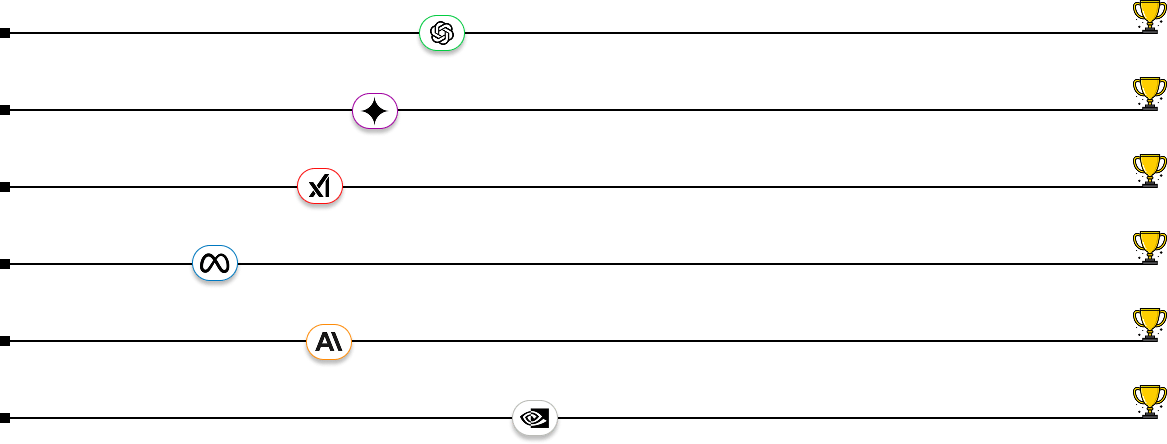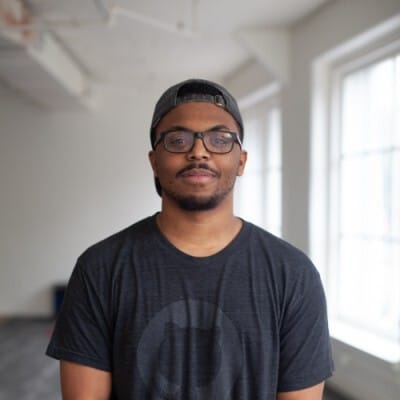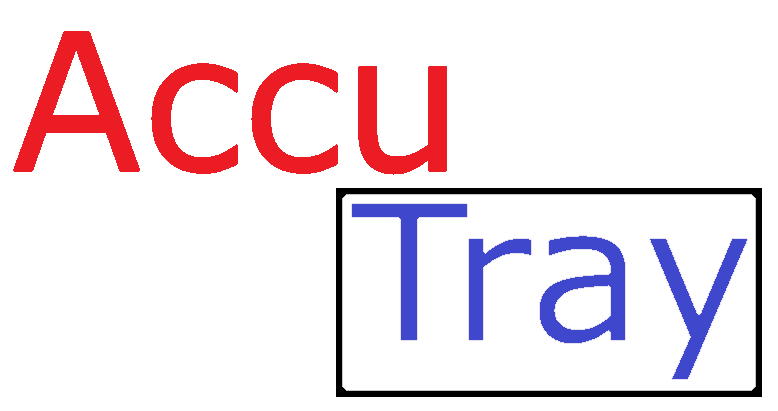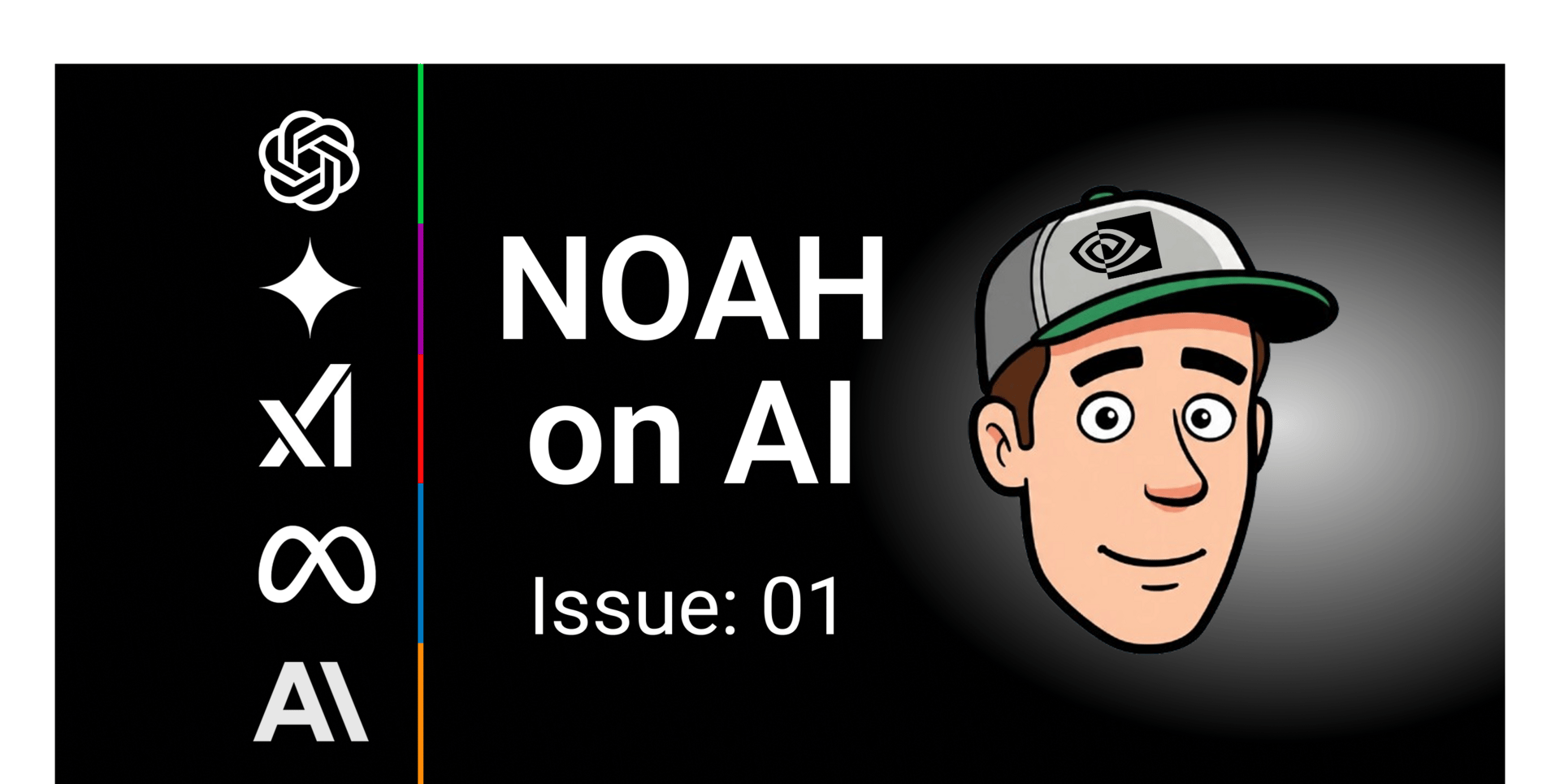🌟 Editor's Note
Since this is the 1st release, I will be recapping the AI landscape from 07/01/25 - 07/14/25. Moving forward, I will be tracking primarily on a weekly basis.
🎇✅ Welcoming Thoughts
Welcome to the 1st edition of NoahonAI.
What’s included: company moves, a weekly winner, AI industry impacts, practical use cases, and more.
This week’s interview is with a senior developer on his AI usage and how the next-gen should be thinking about theirs. Must-read for software engineers.
I often use the term “AI race,” but it’s really not winner takes all. Each of the major players, which I call the NVIDIA5, has a path to its own kind of victory. That’ll become more apparent over time.
I’ll be dropping a couple blogs soon. One is called “Basics & Buzzwords,” for anyone who wants a clearer view of what each company actually does.
Some features I mention are only available on paid plans. I’ll try and flag those going forward. I’m subscribed to GPT-4, Claude, and Gemini. I’d recommend using at least one or two paid models if you aren’t already.
Let’s get started—plenty to cover this week.
👑 This Week’s Winner: NVIDIA
When you briefly become the 1st publicly traded company in history with a $4T market cap, it’s pretty easy to win the week. Demand for NVIDIA continue to skyrocket as they maintain a staggering 90% of AI GPU market share. The only barrier to NVIDIA’s growth at the moment are the US export rules which forbid the sale of top-of-the-line chips to China. The lost revenue potential is estimated at $8B in Q2, however it is factored into their financial forecasts.

From Top to Bottom: Open AI, Google Gemini, xAI, Meta AI, Anthropic, NVIDIA.
⬇️ The Rest of the Field
Who’s moving, who’s stalling, and who’s climbing: Ordered by production this week.
🔵 Meta // Meta AI
Hiring Hiring Hiring: Meta just spent hundreds of millions of dollars hiring AI talent. Hires include former Github CEO Nat Friedman, Scale AI CEO Alexandr Wang, and Apple AI Foundational Model Lead Ruoming Pang - on a deal worth more than $200M.
Here’s the Plan: Meta merged its AI units into a new SuperIntelligence Lab and pledged $65B for AI efforts in 2025, including the deployment of 1.3 million GPUs.
PlayAI Acquisition: On July 12th, Meta acquired voice-AI startup PlayAI for $225M to power assistants across Instagram, WhatsApp, and its AI characters. Sneaky good move for AR/VR, Meta’s clearest long term edge in the AI race.
🟣 Google // Gemini
Veo3 is WILD: Gemini’s Veo3 continues to lead the NVIDIA5 in video generation capability. You can now upload a photo, prompt it with speech, movement etc. and turn the photo to an 8 second video clip. More on this later.
Coding Acquisition: After OpenAI failed to close the deal with Windsurf, Google swooped in and acquired the software startup for $2.4B. Deal terms were unfavorable for Windsurf employees. Remaining Windsurf IP/Team was just acquired by Cognition Labs.
Spatial Capabilities: On July 3rd Gemini added visual reasoning. I.e. this allows it to not only identify drinks in the fridge, but also break down calorie counts. Important for robotics, AR, and embodied AI.
🟢 OpenAI // ChatGPT
AI Web Browser: OpenAI plans to release a browser to natively compete with Chrome. The browser will swap “clicks and tabs” for conversational navigation.
Failed Acquisition: After months of negotiation, OpenAI failed to close a rumored $3B acquisition of coding assistant Windsurf.
Feature Drop: Updates across voice, search, and productivity, and new file + chart tools for data analysis.
🔴 xAI // Grok
Grok 3 Last Words: On its final day, Grok 3 repeated antisemitic content and referred to itself as “MechaHitler.” The incident happened because Grok treated X posts as factual instead of contextual references.
Grok 4 Release: Released on July 9th, Grok 4 focuses on math and physics problem-solving. It placed 2nd on FrontierMath (behind OpenAI’s 04-mini) and 1st on Humanity’s Last Exam, scoring 25.4% across 2,500 human-benchmark questions.
Elon AI: xAI is currently a private company, but it’s growing within Elon’s system. SpaceX just invested $2B into xAI. Grok will be integrated into Tesla vehicles this month. IMO this is all leading up to what should be a game changing integration of Grok into Tesla’s humanoid robots.
🟠 Anthropic // Claude
Education Impact: Claude for Education expanded its April 2 launch by adding integrations with Canvas, Panopto, and Wiley. Students can now pull lecture notes and conduct research directly inside Claude.
Slow Service: Claude experienced service slowdowns and timeouts across the first two weeks of July, mostly impacting API users. Anthropic attributed the issues to backend scaling efforts.
Push for Regulation: On July 7, Anthropic released a detailed proposal urging major AI companies to publicly disclose how they test and manage risks.
🎨 Impact Industries 🚑
Creative // Video
Holy smokes! This might be one of the coolest AI use cases I’ve seen. Gemini’s new Veo3 update can generate 8-second videos with sound from a single still photo. That’s not just simulated motion, but motion with audio, opening the door to synthetic memories. Imagine pairing it with a cloned voice and higher recreation video quality. You could recreate a memory with a loved one who has passed, or gift someone a moment that never happened, but still feels real. The tech is still early, but its crazy to think about. We’re entering Black Mirror territory. Think S7 E5 “Eulogy”.
Health // Diagnostics
Researchers at Mount Sinai and Memorial Sloan Kettering trained an AI model to detect cancer-causing mutations by scanning biopsy slides. In early trials, the AI accurately flagged EGFR mutations in lung tumors, which cut the need for rapid DNA testing by over 40%. That means faster treatment, fewer invasive procedures, and smarter use of limited tissue samples. Identifying the presence or absence of EGFR mutations helps doctors decide whether targeted therapies will be effective or a waste of time. It’s a big step toward faster, more personalized cancer care.
👨💻 Practical Use Case: Voice Mode
Difficulty: Basic
Perhaps the most overlooked aspect of the AI renaissance is voice mode. Voice mode works with Gemini, Grok, and Claude, but I personally use advanced voice mode in ChatGPT (requires the $20 subscription for full access, and in my opinion, there’s a huge difference between standard and advanced).
The cool thing about voice mode is that you can have intelligent, productive conversations without being glued to a screen. You can talk to the AI in the car, on a walk, while cooking, or just chilling. Learn new topics, check the news, talk through business ideas, or even pick up a new language.
It’s also just as powerful while you work. I’ll often have voice mode running in the background on my PC during research or writing. Without switching tabs or breaking flow, I can ask Chat for word suggestions, brainstorm ideas, or clarify quick questions. Honestly, it’s the best part of AI right now.
And the potential is massive. People are already experimenting with AI agents using voice mode in all kinds of ways. One example I’ve seen (use caution!) is letting voice mode chat with kids and help teach them for a few minutes.
Just don’t forget to turn it off when you’re done!
Odd: After a recent update, it started adding a bunch of “uhh” and “umm” fillers to sound more human, though I think that’s been mostly cleaned up now.
🎙 Weekly Interview: Kamari Wright

Kamari Wright
🏠 Background: Born and raised in Atlanta, Georgia. Majored in Comp-Sci and ENG at The Ohio State University.
💼 Work: Senior software engineer at Volantia, a small startup positioned in the airline space.
🚀 Quote: If you turn on the TV today, there’s the Wimbledon final, there’s Fox News talking about interest rates, there’s CNN talking about politics, but nothing about LLMs or AI whatsoever. The revolution is not being televised. But it’s happening now.
Noah Weisblat: Alright, let’s start. Give me your name, where you work, what city, and a little bit about yourself.
Kamari Wright: Great question. My name is Kamari Wright. I reside in Atlanta, Georgia, where I was born and raised. I currently work for a small startup in the airline space called Volantia.
Noah Weisblat: Okay. What do you do for Volantia?
Kamari Wright: I’m a senior software engineer. I maintain one of the legacy products-it’s called Smart Alerts. I’m also working on introducing AI and large language models in various ways throughout our workflow.
Noah Weisblat: Okay. How long have you been an engineer for? Did you just start vibe coding a year ago, or did you go to school for it?
Kamari Wright: I’ve been programming since I was about 15, and I’m 30 now. So it’s been a long 15 years. I attended The Ohio State University, majored in computer science and engineering. My sophomore year, I got my first internship, and that led into a job my junior year. I’ve been working in the industry as a software engineer ever since.
Noah Weisblat: Cool. We'll start big picture, then get into the nitty gritty. How do you see AI in the software engineering space overall? Positive? Negative? Where do you stand?
Kamari Wright: In general, it raises the bar for engineers. It makes life and work harder for entry-level and junior engineers. But for upper-mid to senior engineers, it’s a huge opportunity-it can 5x to 10x your output and value to the business. That’s the high-level view.
Noah Weisblat: Interesting. Out of the "NVIDIA5" AI systems, which ones do you use?
Kamari Wright: For me, the Claude code is just head and shoulders better than any other AI agent out there that can support actual software engineering tasks. And then general questions day to day-just planning and figuring out how we’ll tackle a problem I work with ChatGPT and some of their deep research models.
Noah Weisblat: And where would you kind of put Claude code versus Cursor in the developer area?
Kamari Wright: Unless you give it an MCP connection, it doesn’t interact. That gives an overview of where those two fit for me. Cursor is more of a development environment that facilitates AI usage, while Claude Code is an intelligent agent designed to understand and contribute to your coding goals directly.
Noah Weisblat: Interesting. So if I give you the option between Claude code, Cursor, a sophomore engineer from Ohio State, or someone who just graduated-rank those from one to four on who you’d rather have on your team.
Kamari Wright: I need more context. Am I working with them long-term-like a year or two?
Noah Weisblat: Good question. No, just one project, about a three-month timeline.
Kamari Wright: In order: Claude code, Cursor, then the new grad, then the sophomore.
Noah Weisblat: Interesting.
Kamari Wright: If I have to explain the basics of TypeScript, the frameworks, product and technical requirements-on top of sophomore-level approaches-that alone would take three months. It would be ineffective. But if this were long term, then yes, I’d train someone for future benefit.
Noah Weisblat: So at what point would you choose the recent grad over Claude code?
Kamari Wright: Still go with the person eventually. These tools let you learn faster. You can still be a software engineer-it’s just a different workflow.
Noah Weisblat: Right. And I imagine there’s a big difference between engineers who are fluent in these tools and those who aren’t.
Kamari Wright: Totally. A lot of engineers at tech-adjacent companies are just now accessing ChatGPT or discovering Anthropic. We are still early. It’s not rare to find folks who haven’t touched any of these tools.
Noah Weisblat: So Claude vs Claude code-explain it to me like I’m five.
Kamari Wright: Claude is the LLM-it’s great at basic chat, general knowledge. Claude code is an AI agent built on Claude with tools for dev tasks. They’re different.
Noah Weisblat: Got it.
Kamari Wright: Cursor isn’t a model, it’s a dev environment with AI built in. It lets you feed your code into a model or agent to get work done faster.
Noah Weisblat: I’ve done some engineering in the past, and have also tried to learn with Claude - how real is “vibe coding” for non-engineers?
Kamari Wright: Great for MVPs. Not for production systems. It can help with prototyping, but not secure, production-ready code.
Noah Weisblat: Yeah, I think I saw someone say vibe coding falls apart when security matters.
Kamari Wright: Exactly. So many stories of apps getting hacked in those dev circles on X.
Noah Weisblat: What percent of your job involves AI in some capacity?
Kamari Wright: Only thing I don’t use it for is Slack. Everything else-yes. I treat AI agents like junior devs. I design and plan, they handle boilerplate. 85–90% of my job involves AI in some form.
Noah Weisblat: Makes sense. What about “drop it in and walk away” tasks?
Kamari Wright: Maybe 5%. Things like changing JSON config or client-specific settings. But I still review PRs.
Noah Weisblat: Say you used to be 100% efficient before AI -what are you now?
Kamari Wright: About 3.5x more productive. What took two weeks now takes two to three days.
Noah Weisblat: Wow.
Kamari Wright: I create JIRA tickets with lots of context. Claude code generates PRs. Monday = code gen. Tuesday = review. Wednesday = deploy. It’s a game-changer.
Noah Weisblat: That’s wild. Okay-any big problems with AI? How do you fix them?
Kamari Wright: Hallucinations. Outdated APIs. Overengineering. The fix? Context. People focus on prompts, but context is everything. Give your AI all the background-framework, style, preferences-and you’ll reduce issues. I use config files like Claude.md or Cursor.rules to guide behavior.
Noah Weisblat: Great insight-thank you.
Noah Weisblat: (1) Where is all this in 5 years? (2) What’s your message to high schoolers thinking about CS, and grads wondering if it’s too late?
Kamari Wright: (1) Models will accept way more context. There’ll be specialized agents-restaurants, airlines, etc. (2) If you’re in high school, start now. Tools make learning faster. If you just graduated-build a workflow, build something with AI. You’ll be highly valuable.
Noah Weisblat: Yup.
Kamari Wright: Three high schoolers built CalorieAI-it’s now worth $3.2M. You don’t need a degree. You need to start.
Noah Weisblat: Great advice.
Noah Weisblat: Last question: Rank the “AI Big 6”-NVIDIA, OpenAI, Anthropic, xAI, Google Gemini, Meta.
Kamari Wright: #1 is NVIDIA. They own the hardware race. Everyone else-Claude, Gemini, OpenAI-will own domains: Gemini = Google services. OpenAI = general use. Anthropic = devs. xAI = unfiltered, social-native. Meta = open-source foundation tools.
Noah Weisblat: One more follow-up actually-Meta’s open source approach. What does that mean to you?
Kamari Wright: Open source = freedom. Meta gave us React. Now LLaMA. It’s huge for access-especially outside the U.S for those who can't afford the $100/mo for some of these services. And for those who can it cuts costs and increases margins.
Noah Weisblat: Didn’t realize that. Super interesting.
Kamari Wright: Yeah. It’s big for equity and business.
Noah Weisblat: Any final words?
Kamari Wright: Yeah, I have one thing I want to say. Gil Scott-Heron, famous musician—who’s now deceased, God rest his soul—he used to say something that was very powerful, and I never understood it until now. He used to say, “The revolution will not be televised.” I never understood what it meant. And to some level, it’s about consciousness and how we think. But you can take that and apply it to this technology and understand that this is a revolution in terms of how we approach working as a whole. It’s changing the dynamic of how we accomplish tasks and goals. And it’s not being televised. If you turn on the TV today, there’s the Wimbledon final, there’s Fox News talking about interest rates, there’s CNN talking about politics —but nothing about LLMs or AI whatsoever. The revolution is not being televised. But it’s happening now.
Noah Weisblat: Fascinating.
Kamari Wright: If you work in anything—from sanitation to flying planes—it can help you in some way. So find it. Take some time out. Go use it. Go learn it. And figure out how it can make you better.
Noah Weisblat: Powerful. Thank you Kamari.
Kamari Wright: No problem. Happy to join. Thank you.
🚑 Startup Spotlight

Accutray: A Visual AI Solution to Surgical Inventory Management
The Problem: Missing, broken, or incorrect tools cause average delays of ~10 minutes, per surgery with the patient-care charge averaging $153 per minute. One hospital study estimated $6.75–9.42 million/year lost in chargeable OR time alone.
Nationally, with ~50 million surgical cases per year and delays conservatively averaging $350/case, this results in about $17 billion/year in lost revenue.
The Solution: Accutray leverages visual AI to reduce surgical inventory loss and ensure trays are properly constructed before sterilization and entry to the operating room.
The Backstory: Accutray was founded by two graduate students from Case Western Reserve University who shared a vision for applying AI to solve real-world problems in healthcare. Their goal: bring automation and precision to the overlooked, costly issue of surgical tray inefficiencies.
Funding: Raising $350,000 Pre-Seed
Contact: [email protected]
“It’s not likely you’ll lose a job to AI. You’re going to lose the job to somebody who uses AI”
- Jensen Huang | NVIDIA CEO
If anyone has seen Apple’s R&D team please let me know. Till next time,

